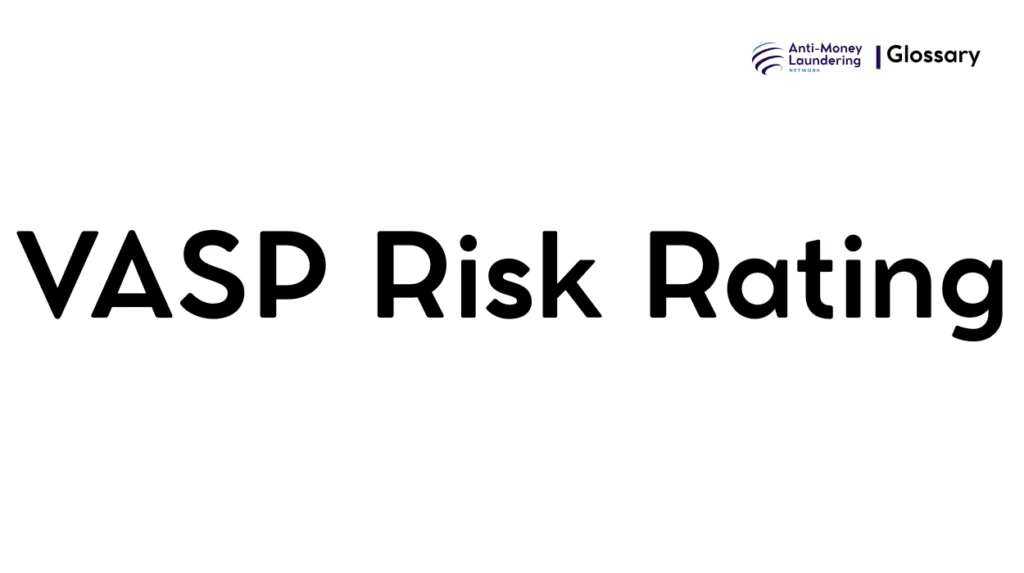Definition
A VASP risk rating in the context of Anti-Money Laundering (AML) refers to the assessment and classification of Virtual Asset Service Providers (VASPs) based on their potential exposure to money laundering, terrorist financing, and other financial crimes. This rating evaluates inherent and residual risks associated with a VASP’s services, operations, geographic exposure, customer base, and transaction types. It enables regulators and financial institutions to gauge how risky a particular VASP is from an AML compliance perspective, guiding the application of appropriate risk mitigation measures.
Purpose and Regulatory Basis
The primary purpose of VASP risk rating is to ensure effective AML risk management within the growing virtual assets sector, helping identify high-risk providers that might facilitate illicit activities. This rating plays a critical role in safeguarding the financial system from abuse by criminals using emerging technologies.
Regulatory frameworks globally have recognized the unique risks posed by VASPs. The Financial Action Task Force (FATF) explicitly includes VASPs in its AML/CFT Recommendations, requiring member countries to regulate and supervise these entities similarly to traditional financial institutions. Key regulations underpinning VASP risk ratings include:
- FATF Guidance on Virtual Assets and VASPs
- USA PATRIOT Act (extended to cover virtual assets)
- European Union’s Anti-Money Laundering Directive (AMLD), especially AMLD5 and AMLD6
These frameworks mandate risk-based approaches, requiring VASPs and supervising authorities to perform institutional risk assessments and maintain controls proportional to identified risks.
When and How It Applies
VASP risk ratings apply when regulatory bodies or institutions assess virtual asset businesses. Use cases include:
- Licensing or registration of VASPs by regulators
- Ongoing supervision and monitoring by financial intelligence units
- Customer Due Diligence (CDD) and Enhanced Due Diligence (EDD) procedures by VASPs themselves
- Risk-based application of controls such as transaction monitoring, sanctions screening, and suspicious activity reporting
For example, a VASP operating in multiple high-risk jurisdictions or facilitating peer-to-peer cross-border transfers may receive a high-risk rating, triggering enhanced AML controls.
Types or Variants of VASP Risk Ratings
VASP risk ratings can be broadly categorized based on the scope and factors considered:
- Institutional Risk Ratings: Assess the overall AML risk of a VASP based on its business model, governance, controls, and operational environment.
- Service-specific Risk Ratings: Focus on particular services provided by VASPs such as exchanges, custody services, or peer-to-peer transfer platforms.
- Geographic Risk Ratings: Evaluate risk levels based on countries or regions the VASP operates in or serves, aligned with FATF’s country risk assessments.
Each rating typically results in classifications such as low, medium, or high risk, which determine the level of scrutiny and regulatory measures imposed.
Procedures and Implementation
To comply with VASP risk rating requirements, institutions must:
- Conduct comprehensive institutional risk assessments identifying inherent threats (e.g., anonymity, cross-border transfers) and vulnerabilities.
- Evaluate the effectiveness of existing AML controls to determine residual risk.
- Maintain detailed documentation of the assessment, findings, and mitigation steps.
- Implement risk-based controls including customer identification, transaction monitoring, recordkeeping, and reporting obligations.
- Continuously monitor and review risk ratings to adapt to evolving threats and regulatory guidance.
Systems such as automated transaction monitoring software, sanctions screening tools, and risk management platforms are critical in managing VASP risk ratings.
Impact on Customers/Clients
From a customer perspective, VASP risk ratings influence the level of due diligence applied. High-risk VASPs may:
- Require customers to undergo enhanced verification and documentation processes.
- Impose transaction limits or restrictions to mitigate risks.
- Monitor customer activity more closely for suspicious behavior.
Customers might experience longer onboarding times or tighter compliance policies based on the risk rating of their VASP provider.
Duration, Review, and Resolution
VASP risk ratings are not static; they require periodic review to reflect changes in operations, regulatory updates, or new risk indicators. Reviews typically occur annually or when significant changes arise in the VASP’s business or external environment. Institutions must resolve identified control deficiencies promptly and update their risk management strategies to maintain compliance.
Reporting and Compliance Duties
Institutions managing or supervising VASPs have responsibilities including:
- Reporting risk assessment outcomes to regulators or supervisory authorities.
- Filing Suspicious Activity Reports (SARs) if illicit activity is detected.
- Keeping records of all risk-related assessments, decisions, and customer due diligence documentation.
- Maintaining a compliance program aligned with regulatory mandates.
Non-compliance with VASP AML requirements can lead to penalties, including fines, license revocation, and criminal prosecution.
Related AML Terms
The concept of VASP risk rating connects closely with other AML elements such as:
- Customer Due Diligence (CDD) and Enhanced Due Diligence (EDD)
- Know Your Customer (KYC) procedures
- Suspicious Activity Reporting (SAR)
- Sanctions screening and compliance
- Institutional risk assessment and risk-based approach (RBA)
Challenges and Best Practices
Common challenges in VASP risk rating include:
- Rapidly evolving virtual asset technologies complicating risk identification.
- Cross-border nature and anonymity features of virtual assets increasing ML/TF risks.
- Limited regulatory clarity in some jurisdictions.
Best practices involve: - Continuous education and training for compliance staff.
- Leveraging updated global guidance and typologies from FATF and law enforcement.
- Integrating advanced technology solutions for risk monitoring and reporting.
- Collaborating with regulators and industry peers to share intelligence and improve controls.
Recent Developments
Recent trends impacting VASP risk rating include:
- Enhanced FATF guidance emphasizing travel rule implementation and token classification.
- Increasing regulatory scrutiny with new jurisdiction-specific VASP regulations.
- Emerging technologies using artificial intelligence and blockchain analytics to better assess transaction risks and detect anomalies.
- Growth of decentralized finance (DeFi) platforms posing novel risk factors for VASPs.
VASP risk rating is a critical AML compliance tool that enables regulators and institutions to assess, classify, and mitigate risks posed by virtual asset service providers. It is grounded in international regulations like FATF Recommendations and requires ongoing risk assessments, reporting, and implementation of risk-based controls. By effectively applying VASP risk ratings, financial institutions can strengthen their defenses against illicit financial activities in the evolving virtual asset landscape.

